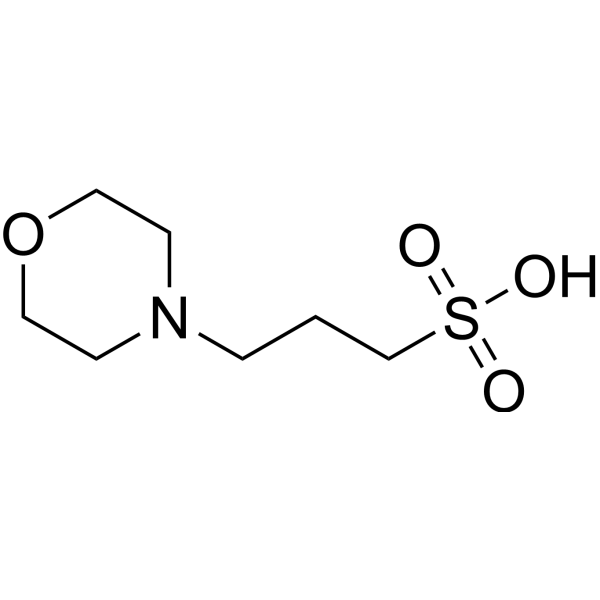
MOPS
CAS No. 1132-61-2
MOPS( 4-Morpholinepropanesulfonic acid | 3-(N-Morpholino)propanesulfonic acid | 3-Morpholinopropanesulfonic acid | Morpholinopropane sulfonic acid )
Catalog No. M28186 CAS No. 1132-61-2
MOPS is commonly used as a buffering agent in biology. MOPS buffer can maintain the pH of mammalian cell culture media.
Purity : >98% (HPLC)
 COA
COA
 Datasheet
Datasheet
 HNMR
HNMR
 HPLC
HPLC
 MSDS
MSDS
 Handing Instructions
Handing Instructions
| Size | Price / USD | Stock | Quantity |
| 500MG | 37 | In Stock |


|
| 1G | Get Quote | In Stock |


|
Biological Information
-
Product NameMOPS
-
NoteResearch use only, not for human use.
-
Brief DescriptionMOPS is commonly used as a buffering agent in biology. MOPS buffer can maintain the pH of mammalian cell culture media.
-
DescriptionMOPS is commonly used as a buffering agent in biology. MOPS buffer can maintain the pH of mammalian cell culture media.
-
In Vitro——
-
In Vivo——
-
Synonyms4-Morpholinepropanesulfonic acid | 3-(N-Morpholino)propanesulfonic acid | 3-Morpholinopropanesulfonic acid | Morpholinopropane sulfonic acid
-
PathwayOthers
-
TargetOther Targets
-
RecptorPlatelet aggregation
-
Research Area——
-
Indication——
Chemical Information
-
CAS Number1132-61-2
-
Formula Weight209.26
-
Molecular FormulaC7H15NO4S
-
Purity>98% (HPLC)
-
SolubilityIn Vitro:?H2O : 50 mg/mL (238.94 mM)
-
SMILESOS(=O)(=O)CCCN1CCOCC1
-
Chemical Name——
Shipping & Storage Information
-
Storage(-20℃)
-
ShippingWith Ice Pack
-
Stability≥ 2 years
Reference
1.Bark BP, et al. Infusion rate and plasma volume expansion of dextran and albumin in the septic guinea pig. Acta Anaesthesiol Scand. 2014 Jan;58(1):44-51.
molnova catalog



related products
-
[D-Tyr27,36, D-Thr32...
[D-Tyr27,36, D-Thr32]-Neuropeptide Y, human
-
Lixisenatide
Lixisenatide is a glucagon-like peptide-1 (GLP-1) receptor agonist that can be used in the treatment of type 2 diabetes mellitus (T2DM).It is an injectable diabetes medicine that helps control blood sugar levels.
-
Tilomisole
Tilomisole (Wy 18251) is an orally available benzimidazole thiazole with anti-inflammatory activity and immunomodulatory activity.Tilomisole is used in the study of cancer and inflammation.



 Cart
Cart
 sales@molnova.com
sales@molnova.com


